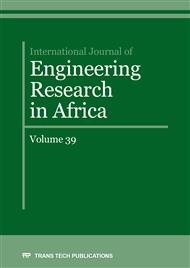[1]
A. Armand, Situation understanding and risk assessment framework for preventivedriver assistance, Ph.D. thesis, Paris-Saclay University, (2016).
Google Scholar
[2]
H.Zhang, J.Wang, Vehicle lateral dynamics control through afs/dyc and robust gain-scheduling approach, IEEE Trans. Veh.Technol. 65 (1):489-494, (2016).
DOI: 10.1109/tvt.2015.2391184
Google Scholar
[3]
H.Grip, L.Imsland, T.A. Johansen, J.C. Kalkkuhl, A.Suissa, Vehicle sideslip estimation: design, implementation, and experimental validation, IEEE Contr. Syst. Mag. 29 (05): 36-52, (2009).
Google Scholar
[4]
H.Du, N.Zhang, F.Naghdy,Velocity-dependent robust control for improving vehicle lateral dynamics, Transportation Research Part C: Emerging Technologies, 19(3):454-468, (2011).
DOI: 10.1016/j.trc.2010.05.004
Google Scholar
[5]
G.Jia, L.Li, D.Cao, Model-based estimation for vehicle dynamics states at the limit handling, IEEE Contr. Syst. Mag 137(10):1-8, (2015).
Google Scholar
[6]
A.Dadashnialehi, A.Bab-Hadiashar, Z.Cao, A.Kapoor, Intelligent sensorless antilock braking system for brushless in-wheel electric vehicles,IEEE Trans. Ind. Electron 62 (03):1629-1638, (2015).
DOI: 10.1109/tie.2014.2341601
Google Scholar
[7]
G. Baffet, A. Charara, D. Lechner, Estimation of vehicle sideslip, tire force and wheel cornering stifness, Control Engineering Practice 17(11):1255-1264, (2009).
DOI: 10.1016/j.conengprac.2009.05.005
Google Scholar
[8]
M. Gobbi, P. andGuarneri, G. Mastinu, G. Rocca, A smart wheel for improving the active safety of road vehicles, in: AVEC, International symposium on Advanced Vehicle Control, Loughborough, UK, (2010).
DOI: 10.1115/detc2010-29059
Google Scholar
[9]
D. Kwapisz, J. Stphant, D. Meizel, Instrumented bearing for force and moment measurements, in: IEEE Sensors - Lecce , Italy, 26-29 Oct.:1480-1483,(2008).
DOI: 10.1109/icsens.2008.4716725
Google Scholar
[10]
H. Mol, Method and sensor arrangement for load measurement on rolling element bearing based on model deformation, uS Patent 7,389,701(Jun. 24 2008).
Google Scholar
[11]
D.Dorrell, A.Vinel, D.Cao, Connected vehicles-advancements in vehicular technologies and informatics, IEEE Trans. Ind. Electron. 62 (12): 7824-7826, (2015).
DOI: 10.1109/tie.2015.2483490
Google Scholar
[12]
A. Stotsky, I. Kolmanovsky, Simple unknown input estimation techniques for automotive applications, American Control Conference: 3312-3317, (2001).
DOI: 10.1109/acc.2001.946139
Google Scholar
[13]
F. E. Saber, M. Ouahi, A. Saka, Vehicle dynamics and steering angle estimation using a virtual sensor, in: Confrence Internationale de concption et de production intgre, CPI15, Tangier, Morocco, (2015).
Google Scholar
[14]
M. Ouahi, A. Rabhi, A. Elhajjaji, Tire force and wheel torque estimation using high gain observer, in: The first international conference on intelligent systems and computer vision, ICSC15, Fez, Morocco, (2015).
DOI: 10.1109/icosc.2015.7152788
Google Scholar
[15]
E. J.Yang, M.Zhou, Front sensor and gps-based lateral control of automated vehicles IEEE Trans. Intell. Transp. Syst. 14 (1):146-154,(2013).
DOI: 10.1109/tits.2012.2207894
Google Scholar
[16]
X.Huang, J.Wang, Identification of ground vehicle steering system backlash J. Dyn. Syst., Meas., Control 135 (01): 1-8,(2012).
Google Scholar
[17]
Z.Gao, C.Cecati, S.X. Ding, A survey of fault diagnosis and fault-tolerant techniques,part i: Fault diagnosis with model-based and signal-based approaches, IEEE Trans. Ind. Electron. 62(06): 3757-3767,(2015).
DOI: 10.1109/tie.2015.2417501
Google Scholar
[18]
M. Segel, Theorical prediction and experimental substantiation of the response of the automobile to steering control, in: Proc. automobile division of the institut of mechanical engineers, (7): 310- 330,(1956).
DOI: 10.1243/pime_auto_1956_000_032_02
Google Scholar
[19]
S. Solmaz, M. Akar, R. Shorten, J. Kalkkuhl, real-time multiple-model estimation of center of gravity position in automotive vehicles, Vehicle system dynamics 46(9):763-788,(2008).
DOI: 10.1080/00423110701602670
Google Scholar
[20]
R. Marino, S. Scalzi, asymptotic sideslip angle and yaw rate decoupling control in four-wheel steering vehicles, Vehicle system dynamics 48(9): 999-1019, (2010).
DOI: 10.1080/00423110903248686
Google Scholar
[21]
M. Boutayeb, M. Darouach, H. Rafaralahy, Generalized state-space observers for chaotic synchronization and secure communication, IEEE Transactions on Circuits and Systems I: Fundamental Theory and Applications 49(3): 345-349, (2002).
DOI: 10.1109/81.989169
Google Scholar


